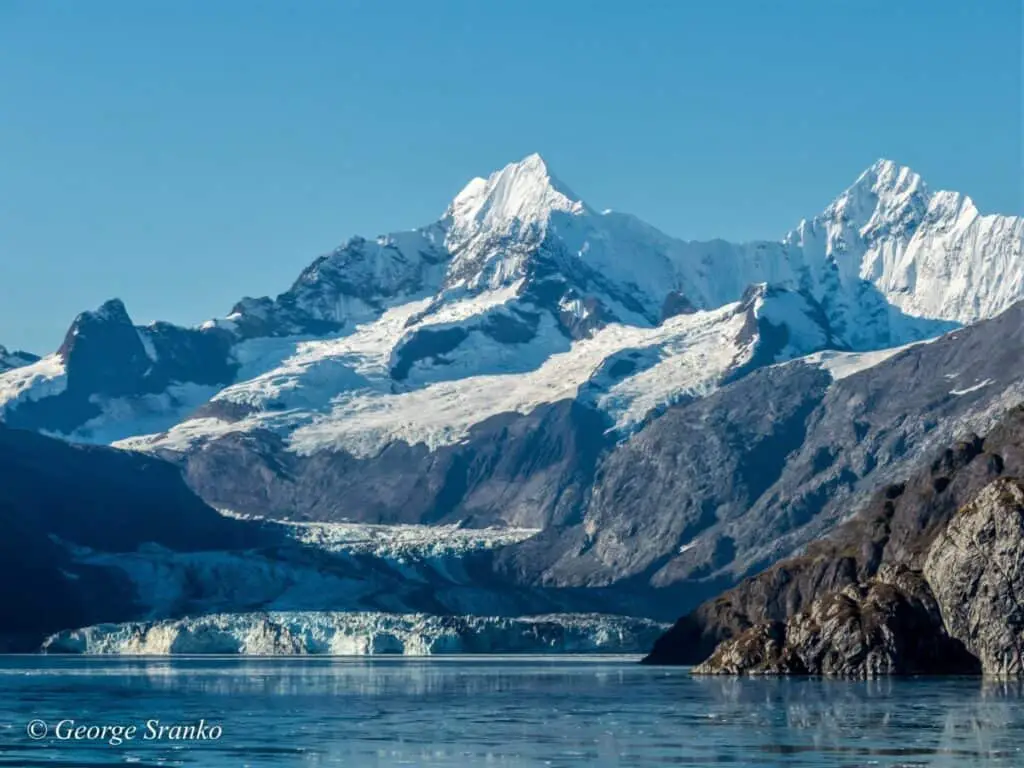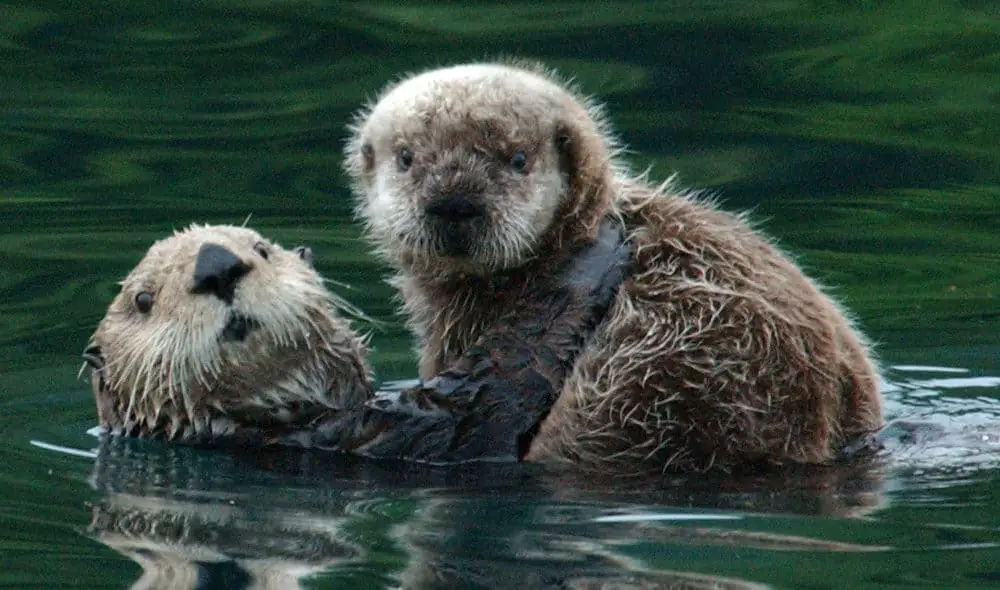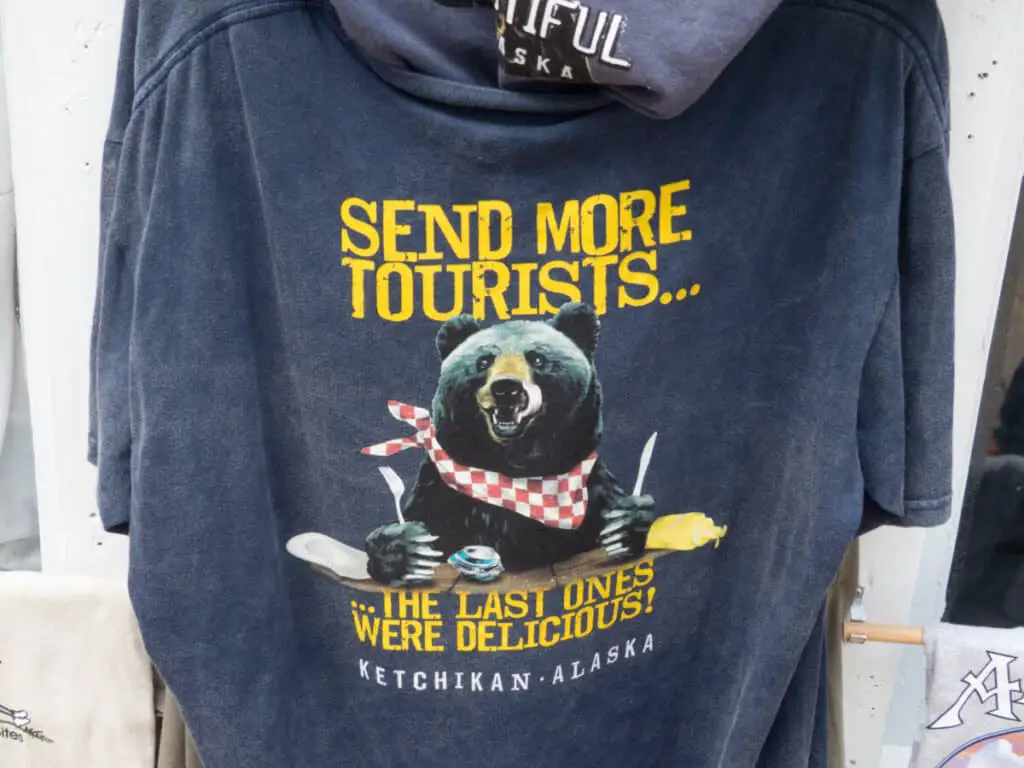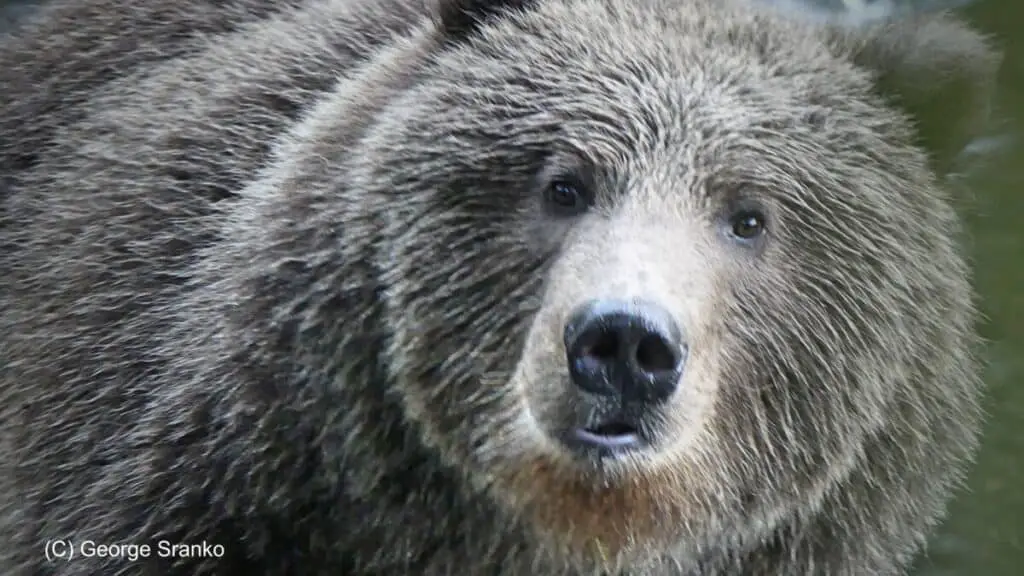As biologists and nature-lovers, our focus in this article is to provide some of the best wildlife watching experiences close to popular cruise ship ports. Here are four of our favorite cruise ports in Alaska for experiencing wildlife and nature:
Glacier Bay
Ketchikan
Seward
Kodiak Island
We have been to each of these ports and would love to go back because of the abundant birds and wildlife. We also found outstanding photo opportunities in each of these destinations.
Glacier Bay, Alaska

background, Glacier Bay National Park. Photo by G. Sranko
Although not a port, Glacier Bay is a wonderful nature destination. It is a real treat for wildlife viewing, especially when the park naturalists come on board the cruise ships to give informative and entertaining talks.

You have a good chance of seeing humpback whales, agile mountain goats on the cliffs, harbor seals on the ice floes, playful sea otters, and bald eagles gliding overhead. You may also spot huge Stellar sea lions, colorful puffins, pigeon guillemots, oyster catchers and even brown or grizzly bears scavenging along the shore.

The sea otters are our favorite animals in Glacier Bay. They are the cutest animals you will see, calmly floating on their backs keeping an eye on you as you peer at them from the ship’s deck. You have a good chance of seeing pups during the cruise season as they stay together with their mothers for the first eight months. Mothers spend a lot of time grooming the pups perched on their chests.

The pup’s fur is so thick that it traps air and they cannot dive under water! If you are lucky, you will see pups bobbing like corks on the ocean surface, often wrapped in kelp so they don’t drift with the currents. Pups don’t even know how to swim for the first four weeks.
You might see adult sea otters hammering away with two hands as they break open shellfish. This is a perfect example of tool-use by a non-human animal. And you thought only chimps could use tools! Sea otters even have a special ‘pocket’ for storing their favorite stone and snacks while swimming – a loose skin fold under their armpits.
Since adult sea otters can eat 25%-30% of their body weight in one day, they have a big impact on their environment and are considered a keystone species. For example, they love to eat sea urchins that, in turn, can decimate kelp beds if they go unchecked. A balance between sea otters and sea urchins helps to keep the kelp forests healthy, which provides habitat for many fish and invertebrates, such as crabs and barnacles.
The Glacier Bay National Park website offers a bounty of information on viewing local wildlife from a cruise ship.
Ketchikan, Alaska
Wildlife outnumbers people here in the midst of Tongass National Forest with black bears, wolves, mountain goats, black tailed deer, bald eagles and more than 100 species of migrating birds. In the surrounding waters you’ll see sea otters, seals, and sealions, porpoises, orcas and humpback whales. There is a wide variety of local tours to take.

The Deadliest Catch boat on the Bearing Sea Crab Fishermen’s Tour is our top choice for wildlife excitement in Ketchikan. We learned a lot watching the entertaining crew bring up huge traps full of giant crabs and interesting critters, including an octopus. They had the most fascinating stories of how dangerous life at sea can be on the crab boats and how lucky they were to be there to tell us their stories.
The photo opportunities were excellent – the crew took some great shots of us standing beside massive king crabs.

At one point we had a dozen or more bald eagles swooping over us for another great photo opportunity. And then, to top off the day, we had a good view of a humpback whale passing near the boat.

We were intrigued with the history of the boat and exciting video footage of this authentic Bering Sea crab fishing boat battling killer ocean storms in foul weather — as we sailed on the calm protected waters of the inside passage.

Seward, Alaska
If you arrive at the port of Seward in April or May, you have a good chance of seeing migrating Gray whales. Later in the summer, you can drive south to Kenai Fjords National Park and stop at Lowell Point to look for humpbacks and orca whales.
Your best bet for wildlife, especially on a calm day, would be to take a tour boat to the outer bay, where you will have a better chance of seeing various whales, sea otters, sea lions and lots of marine birds.
You can see beluga whales in Alaska!
Beluga whales are on our bucket list – and we want to see them in their native habitat! We always thought we’d have to make a trip up into the Arctic, but then we learned about the opportunity to see them south of Anchorage, Alaska.
Belugas are often seen along Turnagain Arm from mid-July through August when salmon are running. The drive north along the arm, from Seward to Portage is 77 mi and an easy 1 ½ – 2-hour drive. You can identify a beluga by the white finless back breaking the surface along with the small spray from their blowhole.
Belugas are fascinating whales! Sometimes referred to as sea canaries, they use whistles, chirps and clicks to keep in touch with one another and to find prey in murky waters using echolocation. The beluga is the only whale that can bend its neck, which is considered an adaptation to living close to the ice pack and maneuvering to catch prey.
Belugas from the Bering Sea can travel more than 1,500 miles to spend their summers in Eastern Canada. Some belugas also travel up rivers to feast on migrating fish.
Getting around near Seward
Rental cars are available close to the cruise port.
Kodiak Island, Alaska
Kodiak bears
Kodiak island is famous for its bears, of course… Kodiak bears. Kodiaks (Ursus arctos middendorffi) are a subspecies of brown bear or grizzly bear as we refer to them in mainland North America.
Kodiak bears can grow to become huge! Much larger than the average grizzly. Most grizzlies weigh around 115 – 350 kg (250 and 790 lb). A Kodiak bear, on the other hand, can reach 300 to 600 kg (660 to 1,320 lb). The largest on record was a male that weighed 751 kg (1,656 lb), with a hind foot measurement of 46 cm (18 in).
The best way to see Kodiak bears is to join a local guide. Local guides know where to find the bears based on the time of year and their best source of food at the time. If the salmon are running, they will know where the bears tend to hang out.
We were fortunate to find an experienced local guide after asking in the Discover Kodiak Center at 100 E Marine Way. Four of us jumped into his truck and he entertained us with stories of bears and guiding on the island while driving to a spot where he had seen a young bear earlier in the day.
We parked and walked down to the riverside where the coho or ‘silver’ salmon were running. Standing beside a deep liquid-green pool we watched a fisherman pull in a lovely big salmon. Just as we were admiring the salmon our guide silently pointed directly behind us. We turned around to see a young two-year old Kodiak sniffing the air, only about 50 yards away.

We didn’t have time to get nervous! It was an adrenaline rush to see the bear so close! I immediately started filming and managed to get some great photos of the young bear as it ambled across the stream and worked its way along the other side looking for salmon. Wow! What an experience!
Kodiak National Wildlife Refuge Visitor Center
Another must see is the Kodiak National Wildlife Refuge Visitor Center, particularly on a wet miserable day. The displays are exceptionally well done, and you can learn a lot about Kodiak bears, including a great 15-minute video.
You can also admire the complete skeleton of a grey whale. The grey whale has a great ecological niche and a diet I wouldn’t want to emulate! They feed on the worms and organisms in the mud of shallow sea bottoms. The Bering Sea is the major feeding ground for grey whales, and at the center you can learn about grey whale migration from Baja to the Bering Sea.
When is the best time to go to Alaska?
For the best wildlife viewing late June to August is good. However, August can be very rainy and so our recommendation is to aim for July.
Are Alaskan animals dangerous?
Moose harm more people than bears. There are 175,000 moose in Alaska and most injuries are caused by motorists accidentally running into these 1,500-pound animals on the roads. There are about 500 accidents a year. Moose will also attack when protecting their young or hungry and looking for food. The Alaska Fish and Game Dept. recommends ducking and hiding behind a tree, car or building – I’m not kidding. Even though moose are vegetarians you should keep at least 25 yards away and at any sign of aggression forget the photo and beat a hasty retreat to the nearest tree or solid object!
Some bear facts
Keeping a safe distance is even more important with bears. Keep 300 yards away from any bear even a young cub. If you come between a mother bear and her cub, even by accident, she will protect her cub! Be respectful of their space and talk loudly as you walk in bear country and keep together as a group. If they hear you approach, they will try to move out of your way.
Attacks are very rare, especially if you keep your distance. In almost every instance, bears will try to avoid you. Keep in mind that brown or grizzly bears will usually attack for defensive reasons. A black bear, on the other hand, could attack a human in a predatory manner. Never run, back away slowly while continuously facing the bear and talking loudly. If a grizzly makes physical contact play dead. If a black bear becomes aggressive, make lots of noise, raise your arms and look big, and try to scare it off. If it is a black bear, don’t play dead!!
Bearsmart.com offers excellent information on what you need to know regarding bear encounters.
Check Out Our TOP Articles for Even More Fascinating Creatures
- How do Octopus Reproduce? (Cannibalistic Sex, Detachable Penis)
- Do Jellyfish have Brains? How Can they Hunt without Brains?
- Why are Deep Sea Fish So Weird and Ugly? Warning: Scary Pictures!
- Are Komodo Dragons Dangerous? Where Can you See Them?
- Koala Brains – Why Being Dumb Can Be Smart (Natural Selection)
- Why do Lions Have Manes? (Do Dark Manes Mean More Sex?)
- How Do Lions Communicate? (Why Do Lions Roar?)
- How Dangerous are Stonefish? Can You Die if You Step on One?
- What Do Animals Do When They Hibernate? How do they Survive?
- Leaf Cutter Ants – Surprising Facts and Adaptations; Pictures and Videos
- Irukandji Jellyfish Facts and Adaptations; Can They Kill You? Are they spreading?
- How to See MORE Wildlife in the Amazon: 10 Practical Tips
- Is it Safe to go on Safari with Africa’s Top Predators and Most Dangerous Animals?
- What to Do if You Encounter a Bullet Ant? World’s Most Painful Stinging Insect!
- How Do Anglerfish Mate? Endless Sex or Die Trying!
- How Smart are Crocodiles? Can They Cooperate, Communicate…Use Tools?
- How Can We Save Our Oceans? With Marine Sanctuaries!
- Why Are Male Birds More Colorful? Ins and Outs of Sexual Selection Made Easy!
- Why is the Cassowary the Most Dangerous Bird in the World? 10 Facts
- How Do African Elephants Create Their Own Habitat?
- What is Killing Our Resident Orcas? Endangered Killer Whales
- Why are Animals of the Galapagos Islands Unique?
- Where Can You See Wild Lemurs in Madagascar? One of the Best Places
- Where Can You see Lyrebirds in the Wild? the Blue Mountains, Australia
- Keeping Mason Bees as Pets
- Why do Flamingos have Bent Beaks and Feed Upside Down?
- Why are Hippos Dangerous? Why Do They Kill People?

